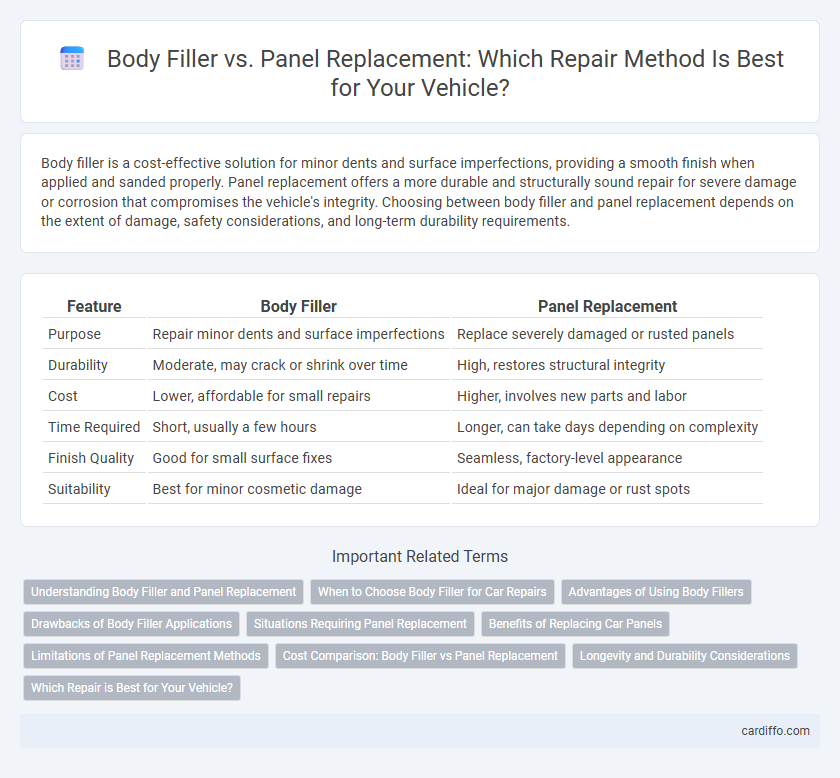Body filler is a cost-effective solution for minor dents and surface imperfections, providing a smooth finish when applied and sanded properly. Panel replacement offers a more durable and structurally sound repair for severe damage or corrosion that compromises the vehicle's integrity. Choosing between body filler and panel replacement depends on the extent of damage, safety considerations, and long-term durability requirements.
Table of Comparison
| Feature | Body Filler | Panel Replacement |
|---|---|---|
| Purpose | Repair minor dents and surface imperfections | Replace severely damaged or rusted panels |
| Durability | Moderate, may crack or shrink over time | High, restores structural integrity |
| Cost | Lower, affordable for small repairs | Higher, involves new parts and labor |
| Time Required | Short, usually a few hours | Longer, can take days depending on complexity |
| Finish Quality | Good for small surface fixes | Seamless, factory-level appearance |
| Suitability | Best for minor cosmetic damage | Ideal for major damage or rust spots |
Understanding Body Filler and Panel Replacement
Body filler is a versatile material used to smooth out minor dents and imperfections on vehicle surfaces, providing a cost-effective solution for small repairs without replacing entire panels. Panel replacement involves removing and installing an entirely new body panel, which ensures structural integrity and is necessary for severe damage or rust that cannot be repaired with filler. Understanding the differences in application, durability, and cost between body filler and panel replacement helps determine the most appropriate repair method for vehicle restoration.
When to Choose Body Filler for Car Repairs
Body filler is ideal for minor dents, small holes, and surface imperfections where the underlying metal is intact, allowing for a smooth and cost-effective repair. It is best used when the damage does not compromise the vehicle's structural integrity or safety. Choosing body filler reduces repair time and preserves original panels, making it suitable for cosmetic fixes rather than extensive damage.
Advantages of Using Body Fillers
Body fillers offer a cost-effective and time-efficient solution for repairing minor dents, dings, and surface imperfections without the need for extensive part replacement. They allow for easy shaping and smoothing, providing a seamless finish that closely matches the vehicle's original contour. Using body fillers reduces labor costs and minimizes the use of new materials, making it an environmentally friendly repair option.
Drawbacks of Body Filler Applications
Body filler applications often lead to durability issues as they can crack, shrink, or peel over time, compromising the vehicle's structural integrity. These fillers provide only a cosmetic fix rather than restoring the original strength of the damaged panel, increasing the risk of corrosion beneath the surface. Additionally, improper application can result in uneven surfaces and poor adhesion, necessitating frequent repairs and reducing the overall lifespan of the repair.
Situations Requiring Panel Replacement
Situations requiring panel replacement include severe structural damage, extensive rust corrosion, and irreparable dents that compromise vehicle safety and integrity. When body filler cannot restore the panel's shape or strength without cracking or sagging, panel replacement becomes necessary. Panel replacement ensures proper alignment, durability, and maintains the vehicle's crashworthiness standards.
Benefits of Replacing Car Panels
Replacing car panels offers significant benefits, such as restoring structural integrity and ensuring optimal safety after collisions. Unlike body filler, panel replacement provides a durable solution that maintains the vehicle's original alignment and prevents future rust or corrosion. New panels also improve the car's resale value by delivering a factory-like finish that filler repairs cannot achieve.
Limitations of Panel Replacement Methods
Panel replacement methods often face limitations such as high labor costs, extended repair times, and potential issues with fitment and alignment, which can affect vehicle safety and aesthetics. The replacement process may also lead to challenges in preserving factory paint quality, increasing the risk of corrosion or mismatched finishes. These constraints make body filler repairs preferable in cases where minor dents or surface damage can be effectively restored without compromising structural integrity.
Cost Comparison: Body Filler vs Panel Replacement
Body filler typically costs between $50 and $150 for minor repairs, making it a budget-friendly solution for small dents and scratches. Panel replacement, on the other hand, can range from $500 to over $2,000 depending on the vehicle's make and model, labor, and parts involved. Choosing body filler reduces immediate expenses but may compromise longevity and structural integrity compared to the more costly, yet durable, panel replacement.
Longevity and Durability Considerations
Body filler offers a cost-effective and quick solution for minor dents and surface imperfections but tends to degrade over time when exposed to moisture and varying temperatures, reducing longevity. Panel replacement involves installing a new or salvaged panel, providing superior durability and resistance to environmental factors, ensuring the repair lasts much longer. Choosing panel replacement is often preferred for critical damage areas where long-term structural integrity and durability are essential.
Which Repair is Best for Your Vehicle?
Body filler is ideal for repairing small dents and scratches, offering a cost-effective and quick solution that restores vehicle aesthetics without extensive labor. Panel replacement is recommended for severe damage where structural integrity is compromised, ensuring long-term durability and safety by installing a new, factory-standard panel. Choosing the best repair depends on damage extent, budget, and desired vehicle performance, with body filler suited for minor cosmetic fixes and panel replacement for critical repairs.
Body filler vs Panel replacement Infographic

 cardiffo.com
cardiffo.com